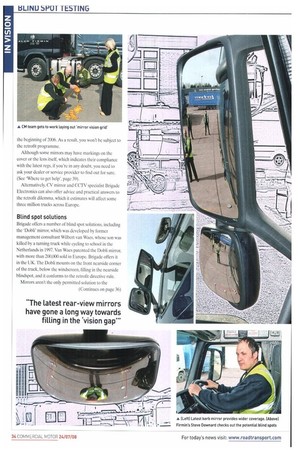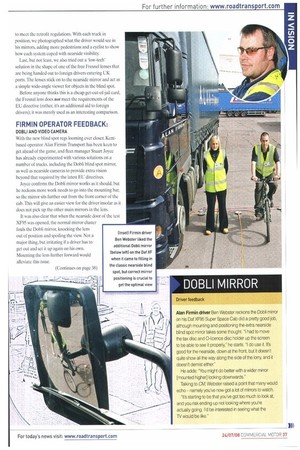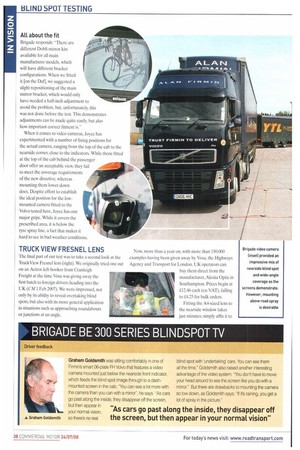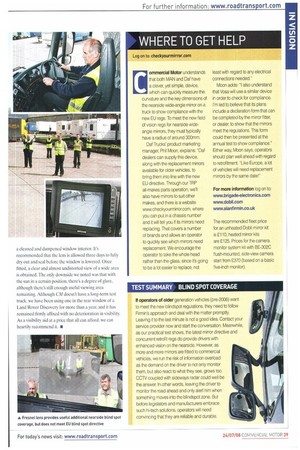MirrPr
Page 32

Page 34

Page 36

Page 37

Page 38

Page 39

If you've noticed an error in this article please click here to report it so we can fix it.
With the latest EU directive on the retrofitting of blind spot mirrors due to kick in next March, we look at the rules and what devices are available to meet them. We've also conducted a practical test to see how they can fill in your 'vision gap'.
Words: Brian Weatherley and Colin Barnett / Images: Graham Richardson It's a story as old as the hills. How do you give a truck driver an extra set of eyes that allows him to see into that classic nearside front blind spot, which, as every operator knows, is a potential accident waiting to happen?
In many respects, the matter has already been taken out of the hands of truck operators. Since 2006, European Union (EU) directive 2003/97/EC has required truck manufacturers to fit revised and improved mirror systems on all HGVs to extend the rearward vision available.
The highly visible large mirror clusters on the current generation of trucks are proof positive of those new regs and while some may argue increasing the size (and number) of mirrors on the mirror arm has had a negative impact on sideways vision, especially when entering junctions or roundabouts, there's no doubt that the latest rear-view mirrors have gone a long way towards filling in the 'vision gap' around the front nearside of a truck.
The need for extra mirrors However, if your truck doesn't have mirrors that conform to the 2003/97/EC directive (typically, because its older than the introduction date) under the retrofit directive 2007/38/EU, which kicks in from 31 March 2009, you may have to get extra mirrors fitted.
Under these regs, the total area a driver needs to see on the nearside has also been extended. Are you ready?
The good news is that your truck may already have mirrors that conform to 2003/97/EC.
Many of the truck manufacturers started fitting the new mirrors well before the current EU directive kicked in at the beginning of 2006. As a result, you won't be subject to the retrofit programme.
Although some mirrors may have markings on the cover or the lens itself, which indicates their compliance with the latest regs, if you're in any doubt, you need to ask your dealer or service provider to find out for sure. (See 'Where to get help', page 39).
Alternatively, CV mirror and CCTV specialist Brigade Electronics can also offer advice and practical answers to the retrofit dilemma, which it estimates will affect some three million trucks across Europe.
Blind spot solutions Brigade offers a number of blind spot solutions, including the `Dobli' mirror, which was developed by former management consultant Wilbert van Waes, whose son was killed by a turning truck while cycling to school in the Netherlands in 1997. Van Waes patented the Dobli mirror, with more than 200,000 sold in Europe. Brigade offers it in the UK. The Dobli mounts on the front nearside corner of the truck, below the windscreen, filling in the nearside blindspot, and it conforms to the retrofit directive rule.
Mirrors aren't the only permitted solution to the problem. Under the regulations, other devices "of indirect vision" (i.e. CCTV systems) can be used to fill the vision gap, and Brigade's BE-300 series can meet the retrofit requirement when fitted on the nearside front of a truck.
However, Brigade's Chris Baker advises: "Under the rules, the requirement for camera systems is infinitely stricter than for mirrors. The cameras must be approved to 2003/97 EC. Typically, they'll have a marking on the monitor. You can't just use any old camera system."
To see what extra vision the latest EU-approved truck mirrors provide to drivers, and what other alternative blind spot devices are available for retrofitting to meet the 2009 directive, we teamed up with Brigade Electronics and Alan Firmin Transport to create a practical 'vision test' to, quite literally, see for ourselves.
Firmin kindly provided us with three artics to show the various options that operators have for improving visibility: • Volvo FH artic this acted as a 'control' truck by having the latest 'standard' mirrors to directive 2003/97/ EC, but with no other extra devices.
• Daf XF95 artic was an 04-plate artic, equipped with the 'old' standard mirrors, but with an additional Dobli blind spot minor, which meets the retrofit directive.
• Volvo FH artic equipped with the latest standard mirrors, plus Brigade's CCTV system on the nearside. which also meets the retrofit directive.
Let testing commence...
With our grid laid out, we parked our control FH artic alongside, before positioning a number of bodies' around the nearside of the vehicle (naturally wearing high-vis vests to conform to Lenham Storage's strict on-site health and safety rules), to see how they appeared in the standard driver's mirrors. Then, using the two artics with the extra Dobli mirror and TV camera, we repeated the exercise to show how the blind spot areas can he filled in to meet the retrofit regulations. With each truck in position, we photographed what the driver would see in his mirrors, adding more pedestrians and a cyclist to show how each system coped with nearside visibility.
Last, but not least, we also tried out a low-tech' solution in the shape of one of the free Fresnel lenses that are being handed out to foreign drivers entering UK ports. The lenses stick on to the nearside mirror and act as a simple wide-angle viewer for objects in the blind spot.
Before anyone thinks this is a cheap get-out-of-jail card, the Fresnal lens does not meet the requirements of the EU directive (rather, it's an additional aid to foreign drivers); it was merely used as an interesting comparison.
FIRM1N OPERATOR FEEDBACK:
DOBLI AND VIDEO CAMERA With the new blind spot regs looming ever closer, Kentbased operator Alan Firmin Transport has been keen to get ahead of the game, and fleet manager Stuart Joyce has already experimented with various solutions on a number of trucks, including the Dobli blind spot mirror, as well as nearside cameras to provide extra vision beyond that required by the latest EU directives.
Joyce confirms the Dobli mirror works as it should, but he reckons more work needs to go into the mounting bar, so the mirror sits further out from the front corner of the cab. This will give an easier view for the driver insofar as it does not pick up the other main mirrors in the lens.
It was also clear that when the nearside door of the test X.F95 was opened, the normal mirror cluster fouls the Dobli mirror, knocking the lens out of position and spoiling the view. Not a major thing, but irritating if a driver has to get out and set it up again on his own. Mounting the lens further forward would alleviate this issue.
All about the fit
Brigade responds: "There are different Dobli mirror kits available for all main manufacturer models, which will have different bracket configurations. When we fitted it [on the Dafl, we suggested a slight repositioning of the main mirror bracket, which would only have needed a half-inch adjustment to avoid the problem, but, unfortunately, this was not done before the test. This demonstrates adjustments can be made quite easily, but also how important correct fitment is.
When it comes to video cameras, Joyce has experimented with a number of fixing positions for the actual camera, ranging from the top of the cab to the nearside corner, close to the indicators. While those fitted at the top of the cab behind the passenger door offer an acceptable view, they fail to meet the coverage requirements of the new directive, whereas mounting them lower down does. Despite effort to establish the ideal position for the lowmounted camera fitted to the Volvo tested here, Joyce has one major gripe. While it covers the prescribed area, it is below the tyre spray line, a fact that makes it hard to see in bad weather conditions.
TRUCK VIEW FRESNEL LENS
The final part of our test was to take a second look at the TruckView Fresnel lens (right). We originally tried one out on an Actros left-hooker from Cranleigh Freight at the time Vosa was giving away the first batch to foreign drivers heading into the UK (CM 1 Feb 2007). We were impressed, not only by its ability to reveal overtaking blind spots, but also with its more general application in situations such as approaching roundabouts or junctions at an angle. Now, more than a year on, with more than 150.000 examples having been given away by Vosa. the Highways Agency and Transport for London. UK operators can buy them direct from the manufacturer, Alenia Optic in Southampton. Prices begin at 1.12.46 each (ex-VAT), falling to £4.25 for bulk orders.
Fitting the A4-sized lens to the nearside window takes just minutes; simply affix it to a cleaned and dampened window interior. It's recommended that the lens is allowed three days to fully dry out and seal before the window is lowered. Once fitted, a clear and almost undistorted view of a wide area is obtained. The only downside we noted was that with the sun in a certain position, there's a degree of glare, although there's still enough useful viewing area remaining. Although CM doesn't have a long-term test truck, we have been using one in the rear window of a Land Rover Discovery for more than a year, and it has remained firmly affixed with no deterioration in visibility. As a visibility aid at a price that all can afford, we can heartily recommend it. •




























































































































































